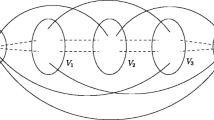Abstract
Most network real-time applications require reliable transmission against incidents such as link failure. Path protection utilizes a link-disjoint secondary path to protect the primary path. Nevertheless, existing path protection schemes have drawbacks in either resource utilization or recovery response from link failure for real-time services. Recently, the \(\alpha +1\) protection was proposed to provide partial bandwidth protection for mission critical data only. The \(\alpha +1\) protection enables fast recovery from link failure with efficient resource utilization. However, finding the optimal pair of primary-secondary paths for \(\alpha +1\) protection remains a challenge. Existing paths-finding algorithms for the \(\alpha +1\) protection utilize the \(K\)-shortest path approach, considerably increasing the algorithm’s complexity. This paper presents a novel exact \(\alpha +1\) path-finding algorithm, called the Toggling Dual Label algorithm, to efficiently identify the optimum solution in polynomial time without utilizing the \(K\)-shortest path algorithm. The proposed algorithm is shown to produce the optimum solution while maintaining a low complexity.























Similar content being viewed by others
References
Bhandari, R. (1999). Survivable Networks: Algorithms for Diverse Routing. Philip Drive Norwell, MA: Kluwer Academic Publishers.
Cinkler, T. (2013). Some more aspects of resilience. Telecommunication Systems Journal, 52(2), 825–846.
Das, A., Martel, C., & Mukherjee, B. (2009). A partial-protection approach using multipath provisioning. In: Proceedings of the IEEE International Conference on Communications, 2009, (pp. 1–5). IEEE
Fang, J., Sivakumar, M., Somani, A. K., & Sivalingam, M. (2005). On partial protection in groomed optical WDM mesh networks. In: Proceedings of the International Conference of Dependable Systems and Networks, 2005, (pp. 228–237). IEEE
Gan, M. L., & Liew, S. Y. (2013). Effective algorithms for finding optimum pairs of link-disjoint paths in \(\alpha +1\) path protection. Telecommunication Systems Journal, 52(2), 783–797.
Gomes, T., Craveirinha, J., & Jorge, L. (2008). An effective algorithm for obtaining the minimal cost pair of disjoint paths with dual arc. Computers & Operations Research, 36(5), 1670–1682.
Guo, Y., et al. (2003). Link-disjoint paths for reliable QoS routing. International Journal of Communication Systems, 16(9), 779–798.
Haddad, A., Doumith, E. A., & Gagnaire, M. (2013). A fast and accurate meta-heuristic for failure localization based on the monitoring trail concept. Telecommunication Systems Journal, 52(2), 813–824.
Haider, A., & Harris, R. (2007). Recovery techniques in next generation networks. IEEE Communications Surveys & Tutorials, 9(3), 2–17.
Ho, P. H., & Mouftah, H. T. (2001). Issues on diverse routing for WDM mesh network with survivability. In: Proceedings of the Computer Communications and Networks, 2001, (pp. 61–66).
Huang, S., Xia, M., Martel, C. U., & Mukherjee, B. (2010). A multistate multipath provisioning scheme for differentiated failures in telecom mesh network. Journal of Lightwave Technology, 28(11), 1585–1596.
Jarry, A. (2013). Fast reroute paths algorithms. Telecommunication Systems Journal, 52(2), 881–888.
Laborczi, P., et al. (2001). Algorithms for asymmetrically weighted pair of disjoint paths in survivable networks. In: Proceedings of the DRCN, 2001, (pp. 220–227).
Leepila, R., Oki, E., & Kishi, N. (2011). Scheme to find k disjoint paths in multi-cost networks. In: Proceedings of the IEEE International Conference on Communications, 2011, (pp. 1–5). IEEE
Martins, E., & Pascoal, M. (2003). A new implementation of Yen’s ranking loopless paths algorithm. 4OR: Quarterly Journal of the Belgian, French and Italian Operations Research Societies, 1(2), 121–133.
Rak, J. (2010). \(k\)-penalty: A novel approach to find \(k\)-disjoint paths with differentiated path costs. IEEE Communications Letters, 14(4), 354–356.
Rak, J., Tipper, D., & Walkowiak, K. (2013). Reliable networks design and modeling (Foreword). Telecommunication Systems Journal, 52(2), 701–703.
Roy, R., & Mukherjee, B. (2008). Degraded-service-aware multipath provisioning in telecom mesh networks. In: Proceedings of the Optical Fiber Communication/National Fiber Optic Engineers Conference, 2008, (pp. 1–3).
Suurballe, J. W., & Tarjan, R. E. (1984). A quick method for finding shortest pairs of disjoint paths. Networks, 14(2), 325–336.
Szigeti, J., & Cinkler, T. (2013). Evaluation and estimation of the availability of p-cycle protected connections. Telecommunication Systems Journal, 52(2), 767–782.
Vajanapoom, K., Tipper, D., & Akavipat, S. (2013). Risk based network design. Telecommunication Systems Journal, 52(2), 799–811.
Walkowiak, K., & Rak, J. (2013). Simultaneous optimization of unicast and anycast flows and replica location in survivable optical networks. Telecommunication Systems Journal, 52(2), 1043–1055.
Yang, B., Zheng, S. Q., & Lu, E. (2005). Finding two disjoint paths in a network with normalized \(\alpha ^{+}\) min sum objective function. Lecture Notes in Computer Science, 3827, 954–963.
Yen, J. Y. (1971). Finding the K shortest loopless paths in a network. Management Science, 17(11), 712–716.
Author information
Authors and Affiliations
Corresponding author
Rights and permissions
About this article
Cite this article
Liew, SY., Gan, ML. Toggling dual label: an exact algorithm for finding the optimal pair of link-disjoint paths in \(\alpha +1\) path protection. Telecommun Syst 61, 451–469 (2016). https://doi.org/10.1007/s11235-014-9964-6
Received:
Accepted:
Published:
Issue Date:
DOI: https://doi.org/10.1007/s11235-014-9964-6




